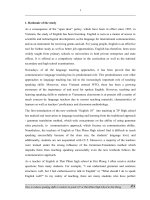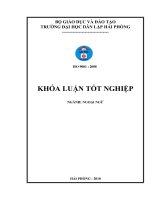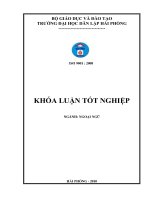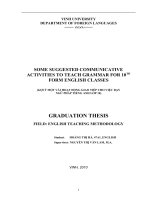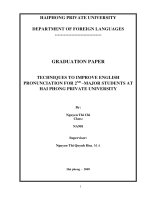Effective techniques to teach English for 1st graders at Vo Thi Sau primary school in Hai Phong city.
Bạn đang xem bản rút gọn của tài liệu. Xem và tải ngay bản đầy đủ của tài liệu tại đây (641.1 KB, 75 trang )
BỘ GIÁO DỤC VÀ ĐÀO TẠO
TRƯỜNG ĐẠI HỌC DÂN LẬP HẢI PHÒNG
ISO 9001 : 2008
KHÓA LUẬN TỐT NGHIỆP
NGÀNH: NGOẠI NGỮ
HẢI PHÒNG - 2010
HAIPHONG PRIVATE UNIVERSITY
FOREIGN LANGUAGE DEPARTMENT
GRADUATION PAPER
A STUDY ON WRITTEN STRUCTURES, PERSONAL
PRONOUN, DECISION AND ATTITUDE
EXPRESSIONS IN COMMERCIAL
CORRESPONDENCE
By:
Đinh Thị Thu Hà
Class:
NA1001
Supervisor:
Mai Văn Sao. MA
HAI PHONG - 2010
BỘ GIÁO DỤC VÀ ĐÀO TẠO
TRƯỜNG ĐẠI HỌC DÂN LẬP HẢI PHÒNG
Nhiệm vụ đề tài tốt nghiệp
Sinh viên: Mã số:
Lớp: Ngành:
Tên đề tài:
Nhiệm vụ đề tài
1. Nội dung và các yêu cầu cần giải quyết trong nhiệm vụ đề tài tốt
nghiệp
( về lý luận, thực tiễn, các số liệu cần tính toán và các bản vẽ).
……………………………………………………………………………
……………………………………………………………………………
……………………………………………………………………………
……………………………………………………………………………
……………………………………………………………………………
……………………………………………………………………………
……………………………………………………………………………
……………………………………………………………………………
2. Các số liệu cần thiết để thiết kế, tính toán.
……………………………………………………………………………
……………………………………………………………………………
……………………………………………………………………………
……………………………………………………………………………
……………………………………………………………………………
3. Địa điểm thực tập tốt nghiệp.
……………………………………………………………………………
……………………………………………………………………………
……………………………………………………………………………
……………………………………………………………………………
……………………………………………………………………………
CÁN BỘ HƯỚNG DẪN ĐỀ TÀI
Người hướng dẫn thứ nhất:
Họ và tên:
Học hàm, học vị:
Cơ quan công tác:
Nội dung hướng dẫn:
Người hướng dẫn thứ hai:
Họ và tên:
Học hàm, học vị:
Cơ quan công tác:
Nội dung hướng dẫn:
Đề tài tốt nghiệp được giao ngày 12 tháng 04 năm 2010
Yêu cầu phải hoàn thành xong trước ngày 10 tháng 07 năm 2010
Đã nhận nhiệm vụ ĐTTN Đã giao nhiệm vụ ĐTTN
Sinh viên Người hướng dẫn
Hải Phòng, ngày tháng năm 2010
HIỆU TRƯỞNG
GS.TS.NGƯT Trần Hữu Nghị
PHẦN NHẬN XÉT TÓM TẮT CỦA CÁN BỘ HƯỚNG DẪN
1. Tinh thần thái độ của sinh viên trong quá trình làm đề tài tốt
nghiệp:
……………………………………………………………………………
……………………………………………………………………………
……………………………………………………………………………
……………………………………………………………………………
……………………………………………………………………………
……………………………………………………………………………
2. Đánh giá chất lượng của khóa luận (so với nội dung yêu cầu đã đề ra
trong nhiệm vụ Đ.T. T.N trên các mặt lý luận, thực tiễn, tính toán số
liệu…):
……………………………………………………………………………
……………………………………………………………………………
……………………………………………………………………………
……………………………………………………………………………
……………………………………………………………………………
3. Cho điểm của cán bộ hướng dẫn (ghi bằng cả số và chữ):
……………………………………………………………………………
……………………………………………………………………………
……………………………………………………………………………
Hải Phòng, ngày … tháng … năm 2010
Cán bộ hướng dẫn
(họ tên và chữ ký)
NHẬN XÉT ĐÁNH GIÁ
CỦA NGƯỜI CHẤM PHẢN BIỆN ĐỀ TÀI TỐT NGHIỆP
1. Đánh giá chất lượng đề tài tốt nghiệp về các mặt thu thập và phân tích tài
liệu, số liệu ban đầu, giá trị lí luận và thực tiễn của đề tài.
2. Cho điểm của người chấm phản biện :
(Điểm ghi bằng số và chữ)
Ngày tháng năm 2010
Người chấm phản biện
ACKNOWLEDGEMENTS
In the process of doing the graduation paper, I have faced up with not only
many problems in lexicology, reference materials but also difficulties in
choosing the right way to express my ideas. However, I have received a lot of
guidance, assistance, and enthusiasm from my supervisor- Mai Van Sao. MA
and other teachers in Foreign Language Department of Haiphong Private
University. Thanks to these helps, I have overcome the difficulties and
completed my graduation paper successfully.
First of all, I would like to express my deep gratitude to Mai Van Sao. MA,
my supervisor, who has given me his whole- hearted assistance, precious
advice, valuable guidance, constant support and cautious correction which
help me much in completing this paper.
My sincere thanks also go to other teachers of Foreign Language Department,
Haiphong Private University for their previously supporting lectures as well
as their dedicated help and advice during my graduation paper.
Last but far from the least, my thanks are presented to my family and many of
my friends for their encouragement, inspiration in the process of completing
this paper.
Sincerely,
Haiphong, June 2010
Student
Dinh Thi Thu Ha
TABLE OF CONTENT
Acknowledgement
Table of content
PART ONE: INTRODUCTION
1. Rationale of the study 1
2. Aims of the study 2
3. Scopes of the study 2
4. Methods of the study 2
5. Design of the study 2
PART TWO: DEVELOPMENT
CHAPTER 1: THEORETICAL BACKGROUND AND OVERVIEW OF
COMMERCIAL CORRESPONDENCE
A, Theoretical background: 4
2.1 Written structures (Kinds of sentence) 4
2.1.1 Definitions 4
2.1.2 Kinds of sentence 5
2.1.3 Sentence and utterance 9
2.1.4 Politeness 10
2.2 Personal pronoun 10
2.3 Decision and attitude expressions (Modality) 12
B, Overview of Commercial Correspondence 18
2.1 Definitions 18
2.1.1 Correspondence 18
2.1.2 Commercial Correspondence 18
2.2 Forms of Commercial Correspondence 19
2.3 Types of Commercial Correspondence 22
2.4 Politeness in Commercial Correspondence 23
CHAPTER 2: A STUDY ON WRITTEN STRUCTURES, PERSONAL
PRONOUN, DECISION AND ATTITUDE EXPRESSIONS IN
COMMERCIAL CORRESPONDENCE
A, A study on written structures in Commercial Correspondence 24
2.1 Overview of sentence kinds in Commercial Correspondence 24
2.2 Sentence kinds in Commercial Correspondence of English in comparison
with one of Vietnamese. 26
2.2.1 Statement 26
2.2.2 Question 31
2.2.3 Command 34
2.2.4 Exclamation 36
B, A study on personal pronoun in Commercial Correspondence 37
2.1 The system of personal pronouns in the salutation 38
2.1.1 The system of personal pronouns in the salutation of letters written in
English 38
2.1.2 The system of personal pronouns in the salutation of letters written in
Vietnamese 40
2.2 The system of personal pronouns in the body: 42
2.2.1 The system of personal pronouns in the body of letters written in
English 42
2.2.2 The system of personal pronouns in the body of letters written in
Vietnamese 44
C, A study on decision and attitude expressions in Commercial
Correspondence (Modality) 46
2.1 Modality in letters written in English 46
2.2 Modality in letters written in Vietnamese 51
CHAPTER 3: FINDINGS AND IMPLICATIONS
A, Findings 53
B, Implications 54
3.1 Solutions 54
3.2 Teaching and learning proposals 56
PART THREE: CONCLUSION
1. Summary of the study 58
2. Some suggestions for further research 58
References 60
Appendix 62
1
PART ONE: INTRODUCTION
1. RATIONALE OF THE STUDY
We all know English is a common language over the world- international
language. Therefore, it plays an important role in activities related to
international scope. Commercial Correspondence is an activity not only
between partners having the same language but also between those having
different language. From that, we can see the necessity of composing and
translating Commercial Correspondence.
The Commercial Correspondence composers and translators not only need to
be armed with knowledge of Commercial English but also have knowledge of
writing skill and translating skill. Those have to be improved day by day.
Commercial Correspondence composing is a little bit different from
Commercial Correspondence translating. The composers need to know clearly
their partners. From that they can compose a letter with their right objective.
A standardized Commercial Correspondence should have its accuracy, purity,
politeness, preciseness, avoid redundancy or going around the bush. If so, the
partners can understand and do as our objectives.
Different from composers, translators may not know clearly the two partners.
They may be the students who translating Commercial Correspondence to
serve their studying requirements. However, translating Commercial
Correspondence from English to Vietnamese or vice versa, translators should
have a certain comparison of form and language of two Commercial
Correspondence languages. In addition, they need to have an abundant
business term sources. So that, they can make the sentences flexible, precise
and easily-understood.
In modern life, using Commercial Correspondence is really important in
trading and financing activities. That‟s why the requirement of composing
and translating skills is higher and higher. However, it‟s not very difficult for
students.
2
As a result, I decide to take “a study on written structures, personal
pronoun, decision and attitude expressions in Commercial
Correspondence” with the hope that students who share the same difficulties
in doing these skills will have different look about this work.
I would like to contribute and share my little knowledge and experience in
Commercial Correspondence composition and translation to all student of
English Department and Economic Department, even to people who work for
company.
2. AIMS OF THE STUDY
My intention to take a study on Commercial Correspondence aims at several
points: It is my purpose to point out an overview on related theoretical
background of Commercial Correspondence, business terms during the study;
the main aims of the study is a comparison of the real status between written
structures, personal pronoun, decision and attitude expressions used in
Business Correspondence, and from then, finds out some strategies to
compose a good letter for students.
3. SCOPES OF THE STUDY
This study mainly focuses on written structures, personal pronoun, decision
and attitude expressions in Commercial Correspondence (50 letters written in
Vietnamese and English) collected from books, newspapers, magazines,
internet, company etc.
4. METHODS OF THE STUDY
As mentioned above, the study is completed thanks to information collected
from internet, books… to get theoretical background. After that, the analysis
on 50 letters is carried out to get basic knowledge and specific
exemplifications. To make the study more persuasive and interesting, some
examples are taken from some close companies and reliable sources.
5. DESIGN OF THE STUDY
My graduation paper consists of three main parts, of which the second part
named Development, chapter 2 is of great importance.
3
PART ONE: INTRODUCTION
Indicates the rationale, the aims, the scopes, the methods and the design of the
study.
PART TWO: DEVELOPMENT
Focuses on the main contents of the study and it is further divided into three
chapters:
Chapter 1: deals with theoretical background together with overview of
Commercial Correspondence.
Chapter 2: namely a study on written structures, personal pronoun,
decision and attitude expressions in Commercial Correspondence with
following key factors: firstly, written structures (sentence); secondly, personal
pronoun; thirdly, decision and attitude expressions (modality).
Chapter 3: refers to some findings and implications I find out during this
study.
PART THREE: CONCLUSION
Gives a brief summary of the study and some suggestions for further research.
4
PART TWO: DEVELOPMENT
CHAPTER 1: THEORETICAL BACKGROUND AND
OVERVIEW OF COMMERCIAL CORRESPONDENCE
A, Theoretical background:
2.1 Written structures (Kinds of sentence)
2.1.1 Definitions
A sentence is the combination of words or phrases on the basic of
grammatical rules like words, concord between the sentence elements and
other rules. It forms the meaningful units which serve the purpose of
communication [16].
A sentence is the largest unit of grammatical organization within which parts
of speech (e.g.: nouns, verbs, adverbs, adjectives…) and grammatical classes
(e.g.: word, phrase, clause) are said to function. In English, a sentence
normally contains one independent clause [15].
A sentence is neither a physical event nor a physical object. It is, conceived
abstractly, a string of words puts together by the grammatical rules of a
language. A sentence can be said of as the ideal string words behind various
realizations in utterance and inscriptions [16].
A sentence is a complete unit of meaning. When we speak our sentences may
be extremely involved or even unfinished. Yet we can still convey our meaning
through intonation gesture, facial expression, etc…When we write these
devices are not available, so sentences have to be carefully structured and
punctuated. A written sentence must begin with a capital letter and end with a
full stop (.), a question mark (?) or an exclamation mark (!) [17: 2].
The meaning of a sentence is not the sum of the meanings of the words used
in the sentence. It is more correct to regard it as the function of the meanings
of the words used in the sentence, modality and structural meanings signaled
by the way that words are organized into a sentence.
5
Here are some definitions of a sentence, far from all. But, these definitions
give us the basic understandings of a sentence. Every linguist has the personal
ideal, so there are many different definitions. In the limited length of paper, it
is not possible and not necessary to sharply urge about them. We find that it is
suitable to give a following definition to the aims of the study: “A sentence is
the largest unit of grammatical organization within which parts of speech
(e.g.: nouns, verbs, adverbs, adjectives…) and grammatical classes (e.g.:
word, phrase, clause) are said to function, normally contains one independent
clause, can be said of as the ideal string words behind various realizations in
utterance and inscriptions”.
2.1.2 Kinds of sentence
Kinds of sentence in language are very complex and they are classified basing
on many different criterions: according to the structure or according to the
communicative function.
a, _ According to the structure (simple sentence, compound sentence,
complex sentence and compound- complex sentence):
Simple sentence contains one finite clause where all sentence elements
are expressed by phrases.
Ex: He is a teacher of English.
Compound sentence contains two or more independent clauses joined by
coordinating conjunctions like and, or, but…etc.
Ex: She said goodbye, and went away.
Complex sentence contains two or more clauses of which one is the
main clause and the other is the subordinate clause.
Ex: We didn‟t understand what she meant.
Compound- complex sentence contains both coordination and
subordination.
Ex: If you want to lose weight, work more and eat less.
6
b,_ According to the communicative function (statement, question,
command and exclamation):
Statement is a sentence in which the subject is always present and
general precedes the verb.
Ex: She is reading.
He isn‟t with me now.
Question often involves subject- operator in version together with rising
intonation or placement of who- element in the initial position (concrete
question later).
Yes/ No question:
General Yes/ No question: formed by placing operator before subject
(plus a rising intonation more often).
- Yes/ No question with positive orientation:
Ex: Has the man left?
- Yes/ No question with negative orientation:
Ex: Can‟t you give us any hope of success?
Tag question (a short question that follows a statement): assumption
and expectation depending on the tone used by the speaker.
Component 1
Component 2
Positive
Negative
Negative
Positive
- Rising tone ( ):
Positive/ negative assumption + Neutral expectation
Ex: He can do these, can‟t he?
Yes, he can./ No, he can‟t.
- Falling tone ():
Positive assumption + Positive expectation
7
Ex: You know him, don‟t you?
Negative assumption + Negative expectation
Ex: They haven‟t finished it, have they?
No, they haven‟t.
Declarative question: this exceptional type of Yes/ No question is
identical in form to a statement, except for the final rising tone.
Ex: You realize what risks are?
Exclamatory question: a question in form but is functionally like an
exclamatory. They are marked by falling instead of rising tone.
Negative: Hasn‟t she grown!
Positive: Did he look annoyed!
Who- question (interrogation)
Who- question on S, O
d
, O
i
, C
s
and modifier on Noun Phrase
Ex: Who went to London?
Wh- question on adverbial or sometimes on C
s
, C
o
with How + Adj
Ex: Where will you come back?
Alternative question:
- Common alternative question:
Ex: Did you come (
) by train or by bus (
)?
We came by bus.
- Alternative plus Yes/ No question: final rising tone requires
either choice of the given options (often with initial “yes”) or
supplement of proper element (when saying “no”).
Ex: Did you go by train or by bus?
Yes, I went by train.
8
No, I went by plane.
- Alternative plus Who- question:
Ex: A: How did you come? (
) By train or by bus? (
)
B: Oh! I came by bus.
Command is a sentence that makes use of the imperative mood in the
main or sometimes of questions with initial modal, particularly with
invitations or requests.
Command without a Subject:
These have imperative finite verb as the main element.
Ex: Leave it at the door.
Command with a Subject:
With “YOU” as a Subject:
Strong irritation:
Ex: You there be quiet!
Singling out two or more distinct addresses:
Ex: You come here, Jack, and you go over there, Mary.
As requests or invitations:
Ex: Will you sit down, please.
With a definite pronoun Subject:
Ex: Everybody shuts their eyes.
Command with “LET”
First person imperatives can be formed by proposing the verb. “LET”
followed by a subject in the objective case.
Ex: Let me see!
9
Exclamation:
Full exclamation:
What + Noun Phrase:
Ex: What an enormous crowd camel!
How + Ad/ Adv:
Ex: How wonderful she was!
Short exclamation (with elliptic Subject and Verb):
What + Noun Phrase:
Ex: What a day!
How + Ad:
Ex: How beautiful!
Ad only:
Ex: Well- done!
To the aims of the study, sentence types are carried out according to the
communicative function.
2.1.3 Sentence and utterance
One may ask why it is necessary to distinguish between sentence and
utterance. The reason lies in the possibility to recognize what meanings are
communicated in language and which meanings are derived from contexts.
Also it makes sense to tell the difference between linguistic meanings which
are communicated by particular units of language and utterance meanings
which occur as truncations between individuals in a particular place, at a
particular time. Basically, what a sentence is to an utterance is just like
language to speech [7: 55].
An utterance is often regarded a stretch of speech before which and after
which there is a pause. An utterance is the USE by a particular speaker, on a
10
particular occasion, of a piece of a language, such as a sequence of sentences,
a phrase or even a single word [7:57].
2.1.4 Politeness
The definition of politeness is really abstract: In the term of culture, politeness
considers as “the idea of polite social behavior or etiquette within a culture”
[2: 60]. Therefore, the rules of politeness reflect sharply in the culture and
they are quite different among languages.
According to Layoff (1973, 1989), politeness as “a system of interpersonal
relations designed to facilitate interaction by minimizing the potential for
conflict and confrontation inherent in all human interchange” [3: 21].
According to John, Gompers and other authors, “politeness as basic to the
production of social order, and a precondition of human cooperation” [4: 13].
According to Leech (1983), politeness as “those forms of behavior which are
aimed at the establish and maintain of “comity”, that is, the ability of
participants in a social communicative interaction to engage an atmosphere
of relative harmony” [4: 104].
In this study, after considering all ideas, we give the definition of politeness:
politeness as “a system of interpersonal relations designed to facilitate
interaction by minimizing the potential for conflict and confrontation inherent
in all human interchange”, as those forms of behavior which are aimed at the
establish and maintain of “comity”.
This definition of politeness will help us choose the main tasks and solve the
materials effectively forward to the aims of the study.
1.2 Personal pronoun
The expression of politeness within the language behaviour is attracting the
interests of the linguistics in general and the pragmatic linguistics in
particular. Politely addressing in communication is under the strong pressure
of community politeness which has the clear expressions such as clearness
and reasonableness. Modesty in addressing, which is considered as the
11
principle of addressing politely in communication, is the way to show the
community politeness.
In Vietnamese, there are many ways to express the thoughts and feelings or
attitude which differ from those in English. The social status, age, sex, and the
family order are distinguished clearly and systematically. This is reflected in a
distinctness clearly and systematically. This is reflected in a number of words
for addressing such as “cụ, ông, bà, bác, cô, chú, thím, dì, dượng, cậu, anh,
chị, ngài, quí vị, mày, em,…”. Such words are generally expressed by English
people in one word “you”. So, personal pronoun is one of the most important
parts that we must major in.
Let‟s consider the below example. This is a dialogue between Jane Eyre (a
young girl) and Mr. Rochester (more 20 years old than Jane) in literature
work “Jane Eyre” [6: 196-205]:
Rochester: “I love you. You, small and poor and plain, I ask you to marry
me!”
Jane: “You want to marry me, I cried, almost beginning to believe him.
But I have no friends, no money, no family”
Rochester: Tôi yêu em! Em, một người con gái nhỏ bé, nghèo và giản dị.
Tôi muốn hỏi cưới em!”
Jane: “Ông muốn cưới em? Tôi nói đầy vẻ ngạc nhiên và tôi bắt đầu cảm
thấy tin ông. Nhưng em không có bạn bè, không có tiền bạc và cũng không
có gia đình.”
And the following example also shows clearly that the translator sometimes
does not master the relationship between the speaker and the hearer leading to
a funny translation. A mother was taking care of her child in hospital. She
said: “I love you very much, dear”. Which was translated as “Em yêu anh lắm,
cưng à” instead of “Mẹ yêu con lắm, cưng à”.
Therefore, in any act of communication, addressing is, so to speak,
unavoidable. Personal pronouns (address forms) not only play an important
role in scientific, legal and commercial documents but also perform pragmatic
functions. It can be said that, any Vietnamese learners of English have some
12
difficulties in speaking, rendering address forms from English into
Vietnamese.
Personal pronouns are pronouns used as substitutes for proper or common
nouns. All known human languages have personal pronouns. We use personal
pronouns, just as nouns, to refer to the people or the things, ideas were talking
about.
The system of personal pronouns in English:
Nominative case
(Chủ cách)
Accusative case
(Tân cách)
Possessive case
(Sở hữu cách)
Personal pronoun
(Đại từ nhân xưng)
I, you, she, he,
we, they
Me, you, her,
him, us, them
Possessive adjective
(Tính từ sở hữu)
My, your, her,
his, our, their
Possessive
(Đại từ sở hữu)
Mine, yours, hers,
him, ours, theirs
In the study, we are going to focus on nominative case (actors).
1.3 Decision and attitude expressions (modality)
Modality expresses the attitude and opinion of the speaker toward the
representational content of the sentence. It is important to realize that
technically “attitude” or “opinion” in this sense has little, if nothing, to do
with the emotional states that a person undergoes. In point of fact, the
interpersonal has to do with the functions of speech. It may be interesting to
know that in pragmatics, this function is often referred to as the “illocutionary
force”. Then the meaning of a sentence is the function of P (proposition) and
F (illocutionary force) [7: 169].
Modality has become an issue of so much interest. Modality helps speakers to
qualify their statements with respect to possibility or necessity. Negation is
13
often treated together with modality since it is connected to the factual status
of a sentence through falsity and denial [7: 174].
English modality can be expressed by the process called grammaticalization
(in the form of mood) and lexicalization (by means of lexical items like modal
verbs and modal adverbs, or some other lexical verbs).
In this research, because of comparison, we are going to focus on modality
expressed by the lexicalization process in details:
Auxiliaries (Các trợ động từ tình thái):
Language is not always used just to exchange information by making simple
statements and asking questions. Sometimes, we want to make requests,
offers, or suggestions, or to express our wishes or intentions. We want to be
polite or tactful, or to indicate our feelings about what we are saying.
Auxiliary is used more often and is the most important part in the decision
and attitude expressions. Auxiliary helps to form a tense or an expression.
They combine with present or past participles or with infinitive to form the
tenses of ordinary verbs.
We can do all these things by using a set of verbs called modals (modal
auxiliaries). Modals form a small but significant part of English. They are
used with other verbs to express (one of the modalities): possibility, ability,
etc… of the action.
(1) Can:
Possibility, ability (Chỉ khả năng, năng lực):
Can you notify us of the availability of the goods? (ability)
Computers can be customized according to users‟ needs. (possibility)
Permission (Sự cho phép):
They can let me pay by monthly installments.
Theoretical possibility (Chỉ khả năng có thể xảy ra theo lý thuyết):
Payment can be made by Banker‟s transfer without any delay.
14
(2) Could:
Past possibility and ability (Chỉ khả năng, năng lực trong quá khứ):
There was a fire at the warehouse last night. We could have lost all our
stock. (past possibility)
They could rarely meet delivery date. (past ability)
Present or future permission (Sự cho phép hiện tại hoặc tương lai):
Could we have 12% discount for any repeated orders?
Contingent possibility in unreal conditions (Chỉ khả năng có thể xảy ra
kèm theo hoặc năng lực trong điều kiện không trong thực tại):
If It was sunny, the unloading could be in good conditions.
We often use “can/ could”, and “will/ would” when we make a request to our
partners, or “can/ could”, and “may” when we ask somebody before doing
something. But “can” and “will” is used with direct actions than “could” or
“would” is used. “Can” is less formal than “may” in this sense.
(3) May:
Permission (Chỉ sự cho phép):
As mentioned above, we use “can” when we need a permission. But, in this
sense, “may” is more formal than “can”. Instead of “may not” or rare
“mayn‟t”, the stronger “mustn‟t” is often used in the negative to express
prohibition.
May I renew loans up to 9 months when they come due in case our
customers fails to make their full payment?
Usually factual possibility (Chỉ khả năng có thể xảy ra trên thực tế):
The goods may be sent on any vessel of the Sellers‟s choice.
(4) Might:
Permission (Chỉ sự cho phép): restricted used.

